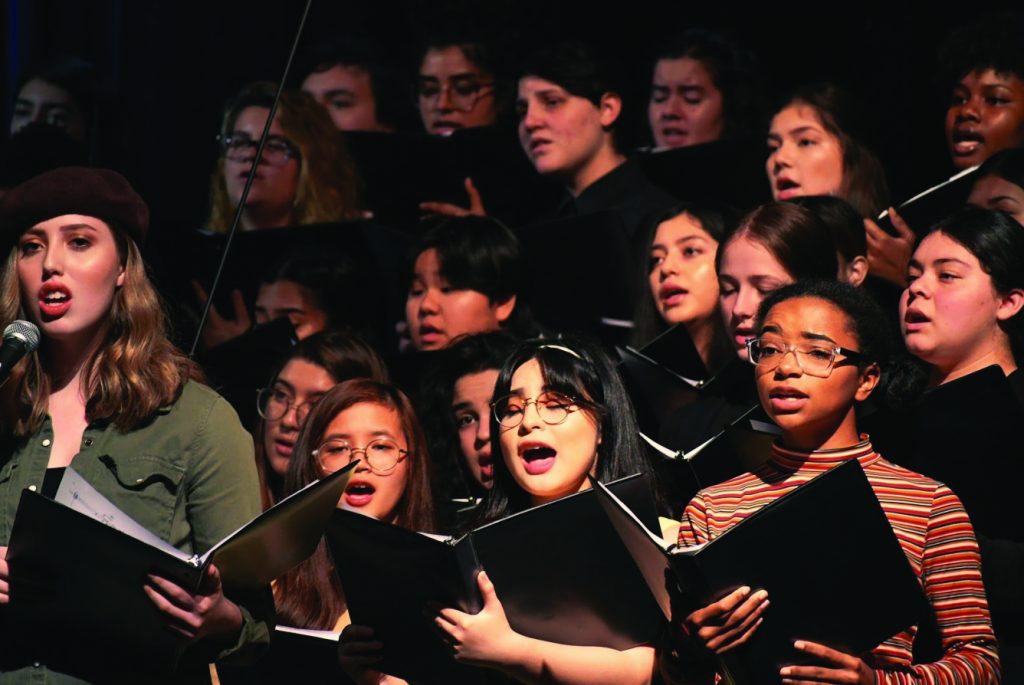“Requiem: This Earth, Our Home” is a new oratorio, written in conjunction with the Los Angeles Master Chorale (LAMC) Voices Within Oratorio Project.
The piece will premiere for fellow students the evening of Friday, Feb. 28, at the Van Nuys High School auditorium.
A performance the following day, Saturday, Feb. 29, at 1 p.m., will be a free community concert and open to the public.
The school chose the theme and the requiem format, but the students themselves wrote and composed the oratorio, which explores the subject of, and the students’ concerns about, climate change.
Doug Cooney, an award-winning writer, is one of the creators of the program and of Voices Within, which originally was geared toward fifth-graders.
Says Lesili Beard, director of Education for the Master Chorale, “We learned there could be an opportunity for students who were more mature emotionally, psychologically, and in terms of what their music skills might be. That’s how the Oratorio Project began.”
Past Oratorio Projects have focused on the East Los Angeles High School Walkouts of 1968, the #metoo movement, and the U.S. incarceration of Japanese citizens during World War II.
Van Nuys is a public Los Angeles Unified School District high school, known for its focus on performing arts.
This year’s program employed three principal teaching artists: Alice Kirwan Murray, lead teaching artist and singer; Doug Cooney, lyricist; and Saunder Choi, composer. Van Nuys choir teacher Brianne Arevalo led the vocal program of 9th- through 12th-grade students.
“We ponder the subject matter for months, researching, asking the students from the previous year or years. The goal is to find an enormous, epic story. It can be historic; it can be mythic.” Climate change is one of the subjects the students themselves brought up.
Once a subject is decided upon, the Master Chorale sets up a couple of Saturdays where they can spend retreat-type time with the students. This year they invited guest speaker Matt Almos from the Climate Reality Project, founded by Al Gore, to come and present the scientific information in a neutral way.
Some of the students subscribed to the notion of climate change, and some didn’t, says Beard. But everyone embraced the idea of a requiem for Mother Earth.
The teaching artists then came in once a week for 20 weeks. Explains Beard: “Doug Cooney might explain the difference between tangible and intangible concepts and how those figure into lyric writing. How do you create the tension, for example, between a hero-type figure and a figure who’s in conflict with the hero?”
Collaboration is at the heart of the program. “We break the story down into small pieces, in this case in accordance with the parts of a Catholic Mass. At the same time, we’re careful not to associate religion with the story, aware that every student may be approaching this from a different spiritual angle, if at all.”
Still, it’s no accident that the oratorio is styled a requiem: the Latin name of a Mass for the dead. Pope Francis’ 2015 encyclical “Laudato si” (“Praise Be to You”), as well speaks poignantly, and with a mixture of alarm and sorrow, of the degradation of “Our Common Home”: that is, of the earth itself.
Groups of four to seven students are assigned to each piece of the story. They tell it in their own words, from their own viewpoint. “We launch with a concept, but we don’t spoon-feed.”
The “Dies Irae,” (“Day of Wrath”) was a natural to be at the center of the recent phenomena of extreme rain, floods, and wildfires. The students chose to include Greta Thunberg, the young climate activist, as a figure in the oratorio.
With the mentoring and assistance of the teaching artists, students wrote the libretto and created melodies for each movement of the requiem. They then auditioned for solo roles and were coached vocally. In performing the oratorio, they will be accompanied by a chamber orchestra comprised of fellow Van Nuys music students and eight LAMC singers.
That adolescents, some of whom may not even have attained their full growth, must suffer the anxiety of a world that seems to be dying, is a deeply somber thought.
Still, youth, and art, contrive to end the oratorio on a positive note.
How can we as individuals take actions, however small, to contribute to a better future? How can we be more mindful in our choices? Adds Beard: “It can be something as small as recycling, or educating ourselves on where our water comes from.”
And the learning curve goes both ways.
“I’ve found from my years of doing the Oratorio Project, here and at the Ramón C. Cortines (Grant Arts) High School, that the students really do have some thoughtful contributions to make. To allow them to share that and to have adults listen has changed many of them,” says Beard.
“In our debriefing sessions after the end of the performances, we’ve heard some incredible stories from students saying, for example, that they were able to talk to their parents, to share ideas or discuss the subjects they were writing about in the oratorio, in ways they never had before. It touches the students on so many levels that the Master Chorale doesn’t necessarily anticipate.”

